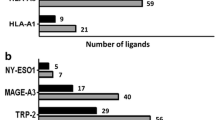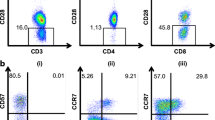Abstract
Melan-A/MART1 is a melanocytic differentiation antigen expressed by tumor cells of the majority of melanoma patients and, as such, is considered as a good target for melanoma immunotherapy. Nonetheless, the number of class I and II restricted Melan-A epitopes identified so far remains limited. Here we describe a new Melan-A/MART-1 epitope recognized in the context of HLA-DQa1*0101 and HLA-DQb1*0501, -DQb1*0502 or -DQb1*0504 molecules by a CD4+ T cell clone. This clone was obtained by in vitro stimulation of PBMC from a healthy donor by the Melan-A51–73 peptide previously reported to contain a HLA-DR4 epitope. The Melan-A51–73 peptide, therefore contains both HLA-DR4 and HLA-DQ5 restricted epitope. We further show that Melan-A51–63 is the minimal peptide optimally recognized by the HLA-DQ5 restricted CD4+ clone. Importantly, this clone specifically recognizes and kills tumor cell lines expressing Melan-A and either HLA-DQb1*0501, -DQb1*0504 or -DQb1*0502 molecules. Moreover, we could detect CD4+ T cells secreting IFN-γ in response to Melan-A51–63 and Melan-A51–73 peptides among tumor infiltrating and blood lymphocytes from HLA-DQ5+ patients. This suggests that spontaneous CD4+ T cell responses against this HLA-DQ5 epitope occur in vivo. Together these data significantly increase the fraction of melanoma patients susceptible to benefit from a Melan-A class II restricted vaccine approach.






Similar content being viewed by others
Abbreviations
- B-LCL:
-
B Lymphocyte cell line
- pHS:
-
Pooled human serum
- TIL:
-
Tumor infiltrating lymphocytes
References
Adhikary D, Behrends U, Moosmann A, Witter K, Bornkamm GW, Mautner J (2006) Control of Epstein-Barr virus infection in vitro by T helper cells specific for virion glycoproteins. J Exp Med 203(4):995–1006
Benlalam H, Labarriere N, Linard B, Derre L, Diez E, Pandolfino MC, Bonneville M, Jotereau F (2001) Comprehensive analysis of the frequency of recognition of melanoma-associated antigen (MAA) by CD8 melanoma infiltrating lymphocytes (TIL): implications for immunotherapy. Eur J Immunol 31(7):2007–2015
Benlalam H, Linard B, Guilloux Y, Moreau-Aubry A, Derre L, Diez E, Dreno B, Jotereau F, Labarriere N (2003) Identification of five new HLA-B*3501-restricted epitopes derived from common melanoma-associated antigens, spontaneously recognized by tumor-infiltrating lymphocytes. J Immunol 171(11):6283–6289
Bennett SR, Carbone FR, Karamalis F, Flavell RA, Miller JF, Heath WR (1998) Help for cytotoxic-T-cell responses is mediated by CD40 signalling. Nature 393(6684):478–480
Bioley G, Jandus C, Tuyaerts S, Rimoldi D, Kwok WW, Speiser DE, Tiercy JM, Thielemans K, Cerottini JC, Romero P (2006). Melan-A/MART-1-specific CD4 T cells in melanoma patients: identification of new épitopes and ex vivo visualization of specific T cells by MHC class II tetramers. J Immunol 177(10):6769–6779
Campi G, Crosti M, Consogno G, Facchinetti V, Conti-Fine BM, Longhi R, Casorati G, Dellabona P, Protti MP (2003) CD4(+) T cells from healthy subjects and colon cancer patients recognize a carcinoembryonic antigen-specific immunodominant epitope. Cancer Res 63(23):8481–8486
Chiari R, Hames G, Stroobant V, Texier C, Maillere B, Boon T, Coulie PG (2000) Identification of a tumor-specific shared antigen derived from an Eph receptor and presented to CD4 T cells on HLA class II molecules. Cancer Res 60(17):4855–4863
Coulie PG, Brichard V, Van Pel A, Wolfel T, Schneider J, Traversari C, Mattei S, De Plaen E, Lurquin C, Szikora JP, Renauld JC, Boon T (1994) A new gene coding for a differentiation antigen recognized by autologous cytolytic T lymphocytes on HLA-A2 melanomas. J Exp Med 180(1):35–42
Danke NA, Koelle DM, Yee C, Beheray S, Kwok WW (2004) Autoreactive T cells in healthy individuals. J Immunol 172(10):5967–5972
Fearon ER, Pardoll DM, Itaya T, Golumbek P, Levitsky HI, Simons JW, Karasuyama H, Vogelstein B, Frost P (1990) Interleukin-2 production by tumor cells bypasses T helper function in the generation of an antitumor response. Cell 60(3):397–403
Fonteneau JF, Larsson M, Somersan S, Sanders C, Munz C, Kwok WW, Bhardwaj N, Jotereau F (2001) Generation of high quantities of viral and tumor-specific human CD4+ and CD8+ T-cell clones using peptide pulsed mature dendritic cells. J Immunol Methods 258(1–2):111–126
Godefroy E, Scotto L, Souleimanian NE, Ritter G, Old LJ, Jotereau F, Valmori D, Ayyoub M (2006) Identification of two Melan-A CD4(+) T cell epitopes presented by frequently expressed MHC class II alleles. Clin Immunol 121(1):54–62
Hansen MB, Nielsen SE, Berg K (1989) Re-examination and further development of a precise and rapid dye method for measuring cell growth/cell kill. J Immunol Methods 119(2):203–210
Jung T, Schauer U, Heusser C, Neumann C, Rieger C (1993) Detection of intracellular cytokines by flow cytometry. J Immunol Methods 159(1–2):197–207
Kawakami Y, Dang N, Wang X, Tupesis J, Robbins PF, Wang RF, Wunderlich JR, Yannelli JR, Rosenberg SA (2000) Recognition of shared melanoma antigens in association with major HLA-A alleles by tumor infiltrating T lymphocytes from 123 patients with melanoma. J Immunother 23(1):17–27
Kawakami Y, Eliyahu S, Sakaguchi K, Robbins PF, Rivoltini L, Yannelli JR, Appella E, Rosenberg SA (1994) Identification of the immunodominant peptides of the MART-1 human melanoma antigen recognized by the majority of HLA-A2-restricted tumor infiltrating lymphocytes. J Exp Med 180(1):347–352
Kobayashi H, Lu J, Celis E (2001) Identification of helper T-cell epitopes that encompass or lie proximal to cytotoxic T-cell epitopes in the gp100 melanoma tumor antigen. Cancer Res 61(20):7577–7584
Kobayashi H, Song Y, Hoon DS, Appella E, Celis E (2001) Tumor-reactive T helper lymphocytes recognize a promiscuous MAGE-A3 epitope presented by various major histocompatibility complex class II alleles. Cancer Res 61(12):4773–4778
Kobayashi H, Wood M, Song Y, Appella E, Celis E (2000) Defining promiscuous MHC class II helper T-cell epitopes for the HER2/neu tumor antigen. Cancer Res 60(18):5228–5236
Labarriere N, Diez E, Pandolfino MC, Viret C, Guilloux Y, Le Guiner S, Fonteneau JF, Dreno B, Jotereau F (1997) Optimal T cell activation by melanoma cells depends on a minimal level of antigen transcription. J Immunol 158(3):1238–1245
Labarriere N, Pandolfino MC, Raingeard D, Le Guiner S, Diez E, Le Drean E, Dreno B, Jotereau F (1998) Frequency and relative fraction of tumor antigen-specific T cells among lymphocytes from melanoma-invaded lymph nodes. Int J Cancer 78(2):209–215
Levy F, Muehlethaler K, Salvi S, Peitrequin AL, Lindholm CK, Cerottini JC, Rimoldi D (2005) Ubiquitylation of a melanosomal protein by HECT-E3 ligases serves as sorting signal for lysosomal degradation. Mol Biol Cell 16(4):1777–1787
Lu Z, Yuan L, Zhou X, Sotomayor E, Levitsky HI, Pardoll DM (2000) CD40-independent pathways of T cell help for priming of CD8(+) cytotoxic T lymphocytes. J Exp Med 191(3):541–550
Mandic M, Castelli F, Janjic B, Almunia C, Andrade P, Gillet D, Brusic V, Kirkwood JM, Maillere B, Zarour HM (2005) One NY-ESO-1-derived epitope that promiscuously binds to multiple HLA-DR and HLA-DP4 molecules and stimulates autologous CD4+ T cells from patients with NY-ESO-1-expressing melanoma. J Immunol 174(3):1751–1759
Manici S, Sturniolo T, Imro MA, Hammer J, Sinigaglia F, Noppen C, Spagnoli G, Mazzi B, Bellone M, Dellabona P, Protti MP (1999) Melanoma cells present a MAGE-3 epitope to CD4(+) cytotoxic T cells in association with histocompatibility leukocyte antigen DR11. J Exp Med 189(5):871–876
Ossendorp F, Mengede E, Camps M, Filius R, Melief C J (1998) Specific T helper cell requirement for optimal induction of cytotoxic T lymphocytes against major histocompatibility complex class II negative tumors. J Exp Med 187(5):693–702
Ridge JP, Di Rosa F, Matzinger P (1998) A conditioned dendritic cell can be a temporal bridge between a CD4+ T-helper and a T-killer cell. Nature 393(6684):474–478
Schoenberger SP, Toes RE, van der Voort EI, Offringa R, Melief CJ (1998) T-cell help for cytotoxic T lymphocytes is mediated by CD40-CD40L interactions. Nature 393(6684):480–483
Schultz ES, Schuler-Thurner B, Stroobant V, Jenne L, Berger TG, Thielemanns K, van der Bruggen P, Schuler G (2004) Functional analysis of tumor-specific Th cell responses detected in melanoma patients after dendritic cell-based immunotherapy. J Immunol 172(2):1304–1310
Seiter S, Monsurro V, Nielsen MB, Wang E, Provenzano M, Wunderlich JR, Rosenberg SA, Marincola FM (2002) Frequency of MART-1/MelanA and gp100/PMel17-specific T cells in tumor metastases and cultured tumor-infiltrating lymphocytes. J Immunother 25(3):252–263
Sotiriadou R, Perez SA, Gritzapis AD, Sotiropoulou PA, Echner H, Heinzel S, Mamalaki A, Pawelec G, Voelter W, Baxevanis CN, Papamichail M (2001) Peptide HER2(776–788) represents a naturally processed broad MHC class II-restricted T cell epitope. Br J Cancer 85(10):1527–1534
Toes RE, Ossendorp F, Offringa R, Melief CJ (1999) CD4 T cells and their role in antitumor immune responses. J Exp Med 189(5):753–756
Wang RF (2006) Immune suppression by tumor-specific CD4+ regulatory T-cells in cancer. Semin Cancer Biol 16(1):73–79
Wang HY, Lee DA, Peng G, Guo Z, Li Y, Kiniwa Y, Shevach EM, Wang RF (2004) Tumor-specific human CD4+ regulatory T cells and their ligands: implications for immunotherapy. Immunity 20(1):107–118
Zarour HM, Kirkwood JM, Kierstead LS, Herr W, Brusic V, Slingluff CL Jr, Sidney J, Sette A, Storkus WJ (2000) Melan-A/MART-1(51–73) represents an immunogenic HLA-DR4-restricted epitope recognized by melanoma-reactive CD4(+) T cells. Proc Natl Acad Sci U S A 97(1):400–405
Zeng G, Wang X, Robbins PF, Rosenberg SA, Wang RF (2001) CD4(+) T cell recognition of MHC class II-restricted epitopes from NY-ESO-1 presented by a prevalent HLA DP4 allele: association with NY-ESO-1 antibody production. Proc Natl Acad Sci U S A 98(7):3964–3969
Acknowledgments
This work was supported by grants from the « Ligue Nationale contre le Cancer » (labelisation 2002–2005).
Author information
Authors and Affiliations
Corresponding author
Rights and permissions
About this article
Cite this article
Larrieu, P., Ouisse, LH., Guilloux, Y. et al. A HLA-DQ5 restricted Melan-A/MART-1 epitope presented by melanoma tumor cells to CD4+ T lymphocytes. Cancer Immunol Immunother 56, 1565–1575 (2007). https://doi.org/10.1007/s00262-007-0300-9
Received:
Accepted:
Published:
Issue Date:
DOI: https://doi.org/10.1007/s00262-007-0300-9




